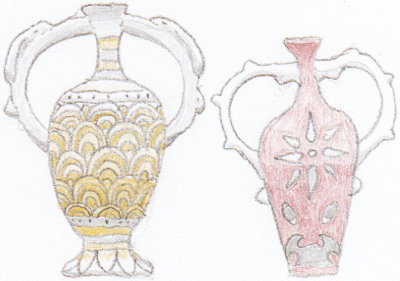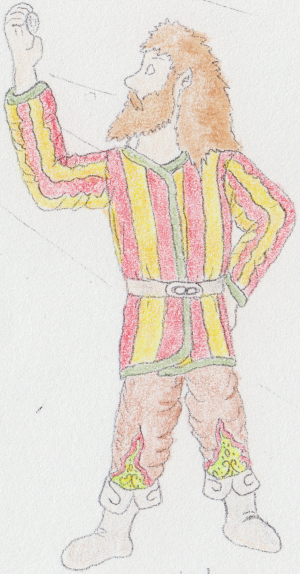Núrakic Elves
Núrakic Elves (or núrakics) is a general term for the various elven ethnicities native to Núrak, which make up the majority of Kingdom of Núrak's population.
New states eventually emerged as things settled down, during which there was a gradual shift from the heavy zameltonían influence of old to a culture with more resemblance to modern núrakic one. When the Paþarían Empire came to power in central Adynía, relations with the nemirkían humans and half-elves improved to the point that some of the eastern city-states became client states of the empire. This was aided by the fact that the paþarían dynasty was the result of a union between the emperor Stárakíus and Tirþena, a núrakic princess.
Núrakic civilization declined once more after the fall of Paþaría, but the wars between its successor states became a unifying factor for the núrakic elves, culminating in the founding of the Kingdom of Núrak.
Rabbits are common in Núrak and are mostly eaten by the common people along with mutton, while wild game such as deer are popular among nobles.
Wine is the drink of choice throughout Núrak as in Nemirkía, though the former rarely dilute the wine with water as Nemirkíans do, instead preferring to mix them with all manner of spices, honey or even perfumes.
Armour varies greatly, from thick, woolen tunics to linothorax-like armour (often reinforced with metal scales), but nobles generally prefer scale armour made of iron, bronze or emerald steel (a lustrous, olive green metal made from Leaf ore commonly found in Núrak). Shields are usually rather small, round or crescent-shaped, although mages traditionally use large, rectangular ones to shield themselves from magic and arrows.Drúantus of Velúsía; mage and leader of a cult of dragon worshippers in the Sjorgús Mountains during the eight century a.Paþ.
Hirdína; the de facto ruler of Núrak.
Núrníus; current king of Núrak.
Óril II; first king of unified Núrak.
Pardalus; the founder of Pardalism.
Þalandes and Taþía; earliest known pilgrims to the thirty-three sacred places of the Sjorgús Mountains.
History
For much of their history, the núrakic elves were divided into numerous tribes subsiding on agriculture, hunting and fishing, which gradually developed into chiefdoms and later kingdoms during bronze age, each centered around fortified towns known as kúþelan. Many of these early kingdoms declined during invasions by human tribes from the Meldon Plain during the fall of Zameltonía, and most of the coastal ones collapsed after repeated attacks by Záali pirates.New states eventually emerged as things settled down, during which there was a gradual shift from the heavy zameltonían influence of old to a culture with more resemblance to modern núrakic one. When the Paþarían Empire came to power in central Adynía, relations with the nemirkían humans and half-elves improved to the point that some of the eastern city-states became client states of the empire. This was aided by the fact that the paþarían dynasty was the result of a union between the emperor Stárakíus and Tirþena, a núrakic princess.
Núrakic civilization declined once more after the fall of Paþaría, but the wars between its successor states became a unifying factor for the núrakic elves, culminating in the founding of the Kingdom of Núrak.
Culture
Apparel
Núrakic clothing is generally similar to that of the Paheiríen-Elves of the Sjorgús Mountains, with notable influence from Nemirkía and especially the Meldon Plain. Men usually wear a jacket of sorts -fastened with a belt- and wide trousers tucked into boots, while women usually wear long-sleeved, high-waisted dresses under a cloak or a blouse-like garment.Art
Pottery
Traditional núrakic pottery, like that of the Marissíans to the southeast, has long featured animal imagery, whether as part of hunting or pastoral scenes or, more recently, by fashioning parts of or the entire vessel in the shape of various fauna. In addition to clay jars, metal vessels are also used, with the most ornate ones being made of gilded silver or emerald steel.Sculpture
Although most núrakic sculptures are made of wood or terracotta, the most prestigious ones are those made from white marble quarried from Mt. Hiril, with marble from around the city of Þúralen being considered the second best. In general, statues of people (warriors in particular) are favored by northern núrakics, while southern núrakics and Þígeans prefer those depicting animals and legendary creatures.Cuisine
Núrakic cuisine is characterized by the use of oats, mutton, rabbit meat, carrots, onions, pears, plums and wine. Dumplings of all sorts, often stuffed with spiced mutton and vegetables, are popular along with the usual staple of bread and porridge. Traditionally, carrots were only grown for their leaves and seeds (a practice that still survives in the northern regions), until new varieties were introduced from Larúnas, which have since been incorporated into a variety of dishes. Red and white carrots are popular in the province of Þígis, yellow ones in Núvar and black ones in Velúsía.Rabbits are common in Núrak and are mostly eaten by the common people along with mutton, while wild game such as deer are popular among nobles.
Wine is the drink of choice throughout Núrak as in Nemirkía, though the former rarely dilute the wine with water as Nemirkíans do, instead preferring to mix them with all manner of spices, honey or even perfumes.
Language
Núrakic elves use several different languages of varying intelligebility, with navalenian (navalede) serving as common tongue. In general, the languages to the south are influenced by larúnean tongue, while the the ones to the far north contain záali loanwords, as the people there often trade with the latter. Like most writing systems in central and western Adynía, núrakic alphabet is derived from ancient zameltonian hieroglyphs. It's the only modern one which still has three different variations of each letter depending on whether it's the first, last or in the middle of a word, as it lacks punctuation.Religion
Like most people of Adynía, núrakic elves are polytheistic, with each community venerating their own local deities alongside a more mainstream pantheon. Some of these cults come from as far as Faron to the east, but most revolve around deities worshipped in the area for millennia.Notable deities
Agor
God of war and the moon, often depicted as a warrior holding a crescent-shaped shield. Agor's role in the east is generally similar to that of Alarus within the Sikíron Empire, while in Úrillía to the north his association with the moon is more prominent.Kíþó
Fertility goddess, often depicted holding a sickle and accompanied by a serpent, either at her feet or wrapped around her left arm. Larúnean and marissían merchants brought Kiþó's cult to Núrak centuries ago. She's especially popular in Úrillía, where a gargantuan statue of her -known as the Colossus of Anúvil- stands in a niche carved into a cliff face overlooking the city of New Anúvil.Nir
Goddess of wilderness and hunting, usually depicted with a spruce wreath on her head. Altars and images of Nir are found throughout Núrak and are frequently visited by hunters, lumberjacks and travellers to ensure a safe journey, as she's believed to unleash bears on those who incur her wrath.Svahirkes
Creator god in the form of a snake, similar to other serpentine gods found in various elven mythologies. He's believed to have fought a primordial bird at the beginning of time, shaping the world into its current form in the process. In some traditions, the moon and the star Þíranis are Svahirkes' eyes, which he lost during the battle, and rivers are believed to be ancient tracks left by him.The Grey Woodsman
A legendary figure found in núrakic folklore, who's variously believed to be a forest spirit, messenger of Nir or the king of wolves. In most stories, those who find themselves lost in the woods can summon The Grey One by offering him some meat, and in exchange he will lead them to the nearest village. If the person has commited serious crimes, he's more likely to lead them to a pack of hungry wolves instead.Warfare
Núrakic warriors have long favored curved falcata-like swords in battle, along with spears and axes, while the bow is considered the weapon of aristocrats.Armour varies greatly, from thick, woolen tunics to linothorax-like armour (often reinforced with metal scales), but nobles generally prefer scale armour made of iron, bronze or emerald steel (a lustrous, olive green metal made from Leaf ore commonly found in Núrak). Shields are usually rather small, round or crescent-shaped, although mages traditionally use large, rectangular ones to shield themselves from magic and arrows.





Comments